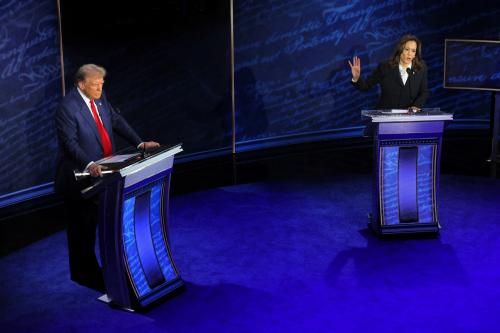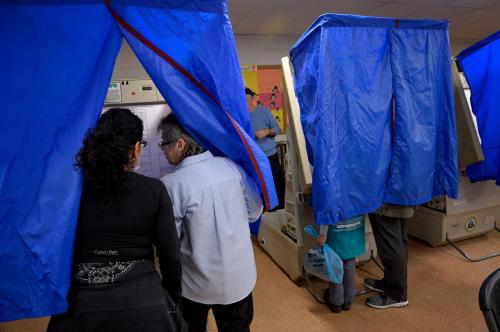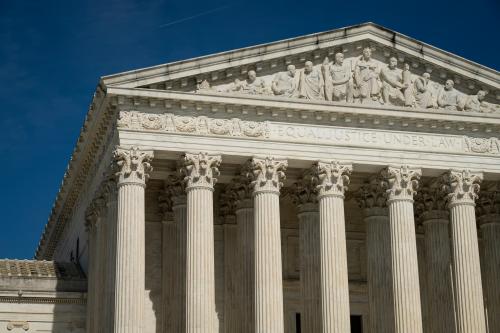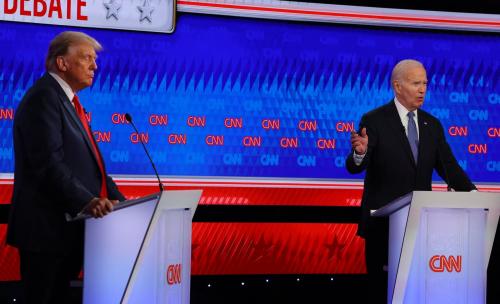The curtain has not yet closed on the 118th (2023-24) Congress. However, President Biden’s nearly four years in the White House offer a window to compare his record of confirming federal judges against those of former President Trump and his predecessors. Focusing on appointments to the federal trial and appellate courts, these new data drive home the impact of party control of the White House and the Senate in a period of polarized parties. What’s more, recent Senate procedural reforms speed the path to confirmation for appellate court nominees and better-aligned confirmation outcomes across the lower rungs of the judiciary.
Biden’s success rate in perspective
We focus on two indicators: the percentage of nominees confirmed each Congress and the duration of the process from nomination to confirmation. Figure 1 shows confirmation rates for nominations to the U.S. District Courts and the U.S. Courts of Appeals.
Over the long postwar period, presidential success in securing Senate confirmation of their appointees varies considerably. Most notable is the marked decline in confirmation rates that began in the 1980s and lasted until a Senate Democratic majority banned filibusters of lower court nominations in 2013. Since then, save for a single period of divided party control of the White House and the Senate in 2015-16, the Senate each Congress has confirmed over half of each president’s appointees. Why the plunge in confirmation success when Republicans held the Senate during President Obama’s final years in office? Led by Republican leader Mitch McConnell (R-Ky.), the GOP Senate all but refused to confirm Obama’s nominations—even taking hostage the Supreme Court vacancy created by the death of Associate Justice Antonin Scalia in 2016.
The GOP Senate uncorked President Trump’s nominations in 2017-18, confirming roughly half of his trial court nominations and about three-fifths of his appellate court picks. Notably, the Democratic Senate in 2021-22 confirmed a slightly higher percentage of Biden’s trial and appellate court nominations than secured by Trump.
Both Senate majority parties contended with the slimmest of margins. Republicans led with a 51-seat majority in 2017-18; Biden’s 50-seat Democratic majority in 2021-22 often had to rely on Vice President Kamala Harris to break ties on contentious nominations. In fact, roughly 80% of Harris’ 33 tie-breaking votes (beating Vice President John C. Calhoun’s record) came on motions related to nominations. An expanded GOP majority in 2019-20 significantly bolstered Trump’s win rate, confirming 82% of district court and nearly every appellate court appointee (a high-water mark for the past half century). We won’t know until the end of this current 118th Congress how Biden’s final two-year record will stack up. Time is running short to catch up to Trump.
Figure 2 plots the average number of days elapsed in each Congress from nomination to confirmation for successful district and appellate court nominations since 1947.
Until recently, the road to confirmation had been getting longer and rockier. At the start of the Trump administration, the GOP-led Senate markedly sped up the process. That swifter pace continued during the second Trump Congress in 2019-20 before leveling off during the Biden years. Republicans’ loss of the House in 2018 ironically seems to have paid dividends for Trump’s judicial nominees. Given split party control of the chambers in 2019-20, the GOP-led Senate largely punted on most party priorities. Thus, McConnell devoted more floor time to processing nominations than considering legislative measures, moving nominees more swiftly and successfully to the bench.
Dynamics driving advice and consent
The data highlight the impact of party control on advice and consent: The Senate confirms a lower percentage of appellate nominees in periods of divided government. Between 1947 and 2022, the Senate confirmed over 80% of appellate court nominees when the president’s party controlled the Senate and under 70% when party control was divided. That difference is even starker over the past decade: The Senate confirmed roughly three-quarters of appellate court nominees in periods of unified control, compared to just 12.5% during the single Congress with divided control. In recent years, trial court nominees have also fared better when the president’s party controlled the Senate.
Why does party control matter more consistently today than before? The two parties are more polarized today, and both care more about the makeup of the bench—at all rungs of the judiciary, especially the Supreme Court—than they did decades ago. In sum, courts and judges are increasingly salient to the fate of both parties’ agendas. Decisions by the federal courts shape the fate of innumerable party priorities—including health and labor, the environment and energy, and voting and reproductive rights, to name just a few.
Because presidents overwhelmingly appoint judges from their own party and because the parties are more ideologically opposed and electorally competitive today than in recent decades, conflict over judges is particularly intense when different parties control the White House and the Senate. Parties pull out the stops to confirm nominees when they control the Senate and White House; they throw sand in the gears when the opposition party holds the White House—lowering the chances and speed of confirmation. There is also ample time today to spend on nominations. Negotiating major bipartisan deals is harder when the parties polarize (or fracture internally), so Senate leaders increasingly dedicate floor time to nominations rather than risk getting bogged down in conflict over the majority’s legislative agenda.
Finally, the rules of the game matter. Frustrated by years of Republican hardball against Democratic appointees, Democrats in 2013 went “nuclear” to ban filibusters of all executive and judicial nominations (save for the Supreme Court). Their procedural move lowered the number of votes required to end debate from 60 votes to just a simple majority. (Republicans followed suit in 2017 to ban filibusters of Supreme Court nominees and in 2019 to reduce the amount of time that must elapse before voting on trial court appointees.)
The 2013 reform shaped advice and consent in two ways. First, as shown in Figure 3, banning nomination filibusters significantly sped up the time to confirmation for appellate nominees. On average, presidents’ picks for the Courts of Appeals now get to the bench roughly two months faster. District court nominations, however, have not moved appreciably faster.
Second, notice in Figure 1 that after 2013, the gap in confirmation rates for trial and appellate appointees shrank considerably. Reforms have strengthened the majority party’s ability to shape the course of advice and consent. When the president’s party controls the Senate, it is much harder for the opposition to derail nominees by throwing sand in the procedural gears. So long as slim majorities remain unified over the president’s picks, nominees at all levels of the federal bench seem to move more swiftly to confirmation and in tandem.









